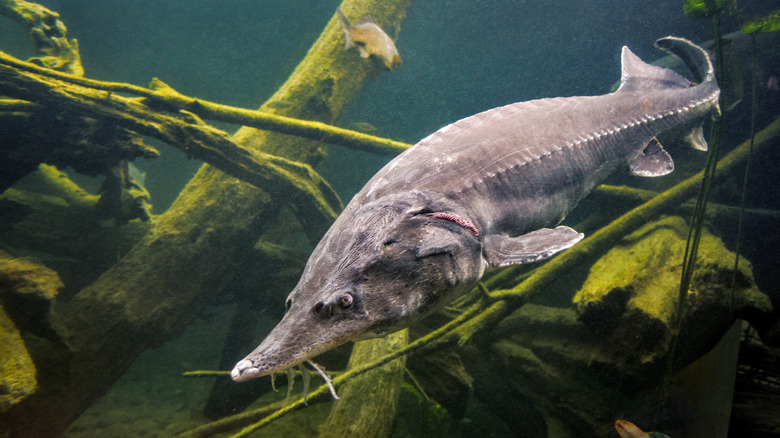List Of Fish That Are Bottom Feeders
The North American fish that feed at the bottom of lakes, rivers, and oceans include some of the most primitive fish in existence. These bottom feeders often possess special adaptations that allow them to easily access the invertebrate creatures, clams, fish, worms, and other potential foods at the bottom of the waters in which they live. The anatomical features that make this possible include a ventral mouth — meaning it points downward — and small appendages of skin called barbels that help the fish feel for food along the bottom.
Sturgeons
Sturgeons are an ancient, nearly prehistoric type of bottom-feeding fish, with their lineage tracing back 350 million years. Sturgeons live in both saltwater and freshwater in North America, with some ocean species traveling up rivers to spawn. Sturgeons have five rows of bony plates running in a longitudinal manner down their bodies, making them appear to have five sides. The ventral mouth lacks teeth, and the fish has four barbels around its mouth to help it locate food on the bottom. Among the types of sturgeon found in American waters are the Atlantic, lake, white, shortnose, and shovelnose sturgeons. While the shovelnose sturgeon averages about 7 pounds, the white sturgeon's weight may exceed 1,000 pounds.
Carp
The carp species present in North American waters was introduced from Asia and Europe. Although the grass carp, a fish that feeds mostly on vegetation, will sometimes feed along the bottom, the common carp is much more of a bottom-feeding type. The common carp, a fish capable of reaching more than 50 pounds, is omnivorous, eating whatever algae, bugs, larvae, invertebrates, and plant matter it discovers on the bottom. Common carp live in rivers, streams, ponds, and lakes throughout North America, and they are able to withstand polluted waters. Common carp disturb the bottom and then use their ventral mouths to grab anything edible. Their teeth are in their throat, with some similar to human molars.
Catfish
The elongated barbels of the catfish resemble the whiskers on a cat, giving this bottom feeder its name. Catfish also possess sharp spines, with one at the base of each of its side fins and another on the top (or dorsal) fin. Catfish have a wide habitat across the continent, living in rivers, lakes, ponds, and reservoirs — any places where the bottom is muddy. Channel catfish, flathead catfish, blue catfish, brown bullheads, and the yellow bullhead are all catfish types. Catfish have a varied diet, feeding on insect larvae, clams, fish, plants, snails, crayfish, and whatever else they may locate on the bottom.
Suckers
Suckers are aptly named, with ventral, fleshy mouths that enable them to suck up food in a manner similar to a vacuum; their teeth are in their throats. Sucker species in North America include the northern hog sucker, the white sucker, the blue sucker, and the quillback. Suckers usually live in flowing rivers and streams, but some kinds, such as the white sucker, inhabit lakes. Invertebrates, plants, mollusks. and insects comprise their diets.
